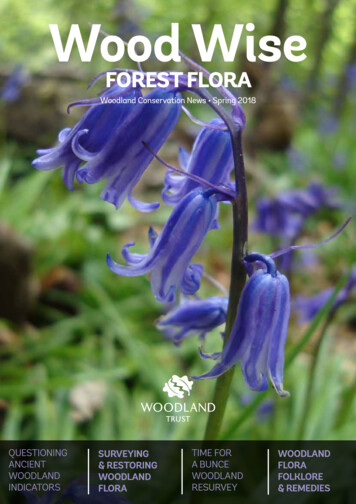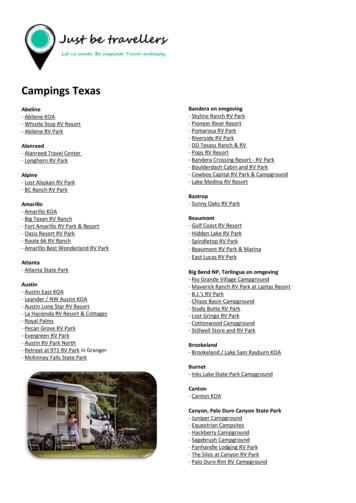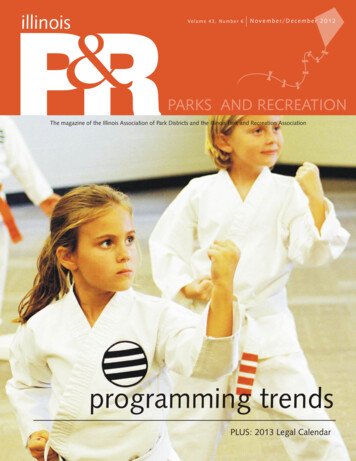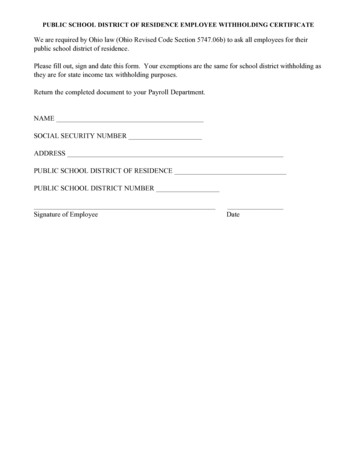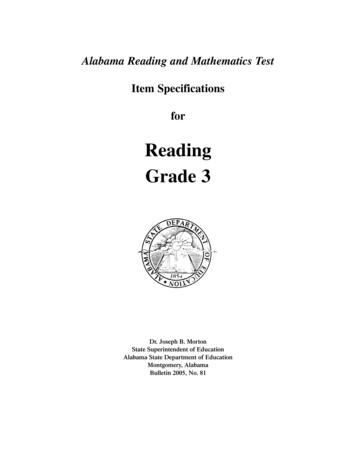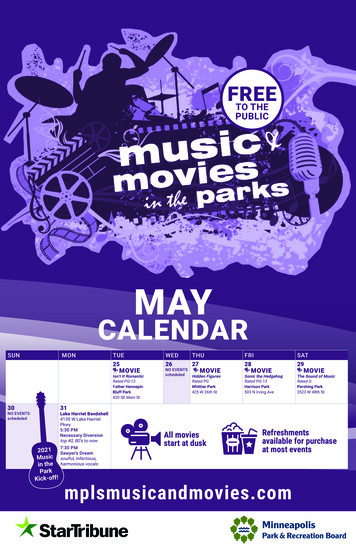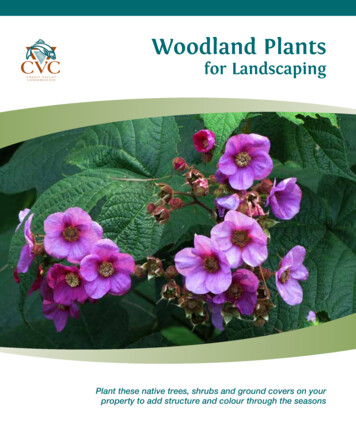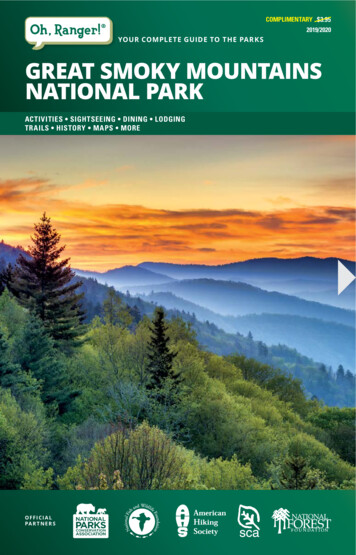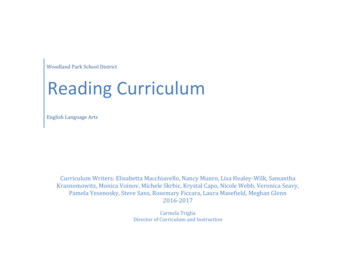
Transcription
Woodland Park School DistrictReading CurriculumEnglish Language ArtsCurriculum Writers: Elisabetta Macchiavello, Nancy Munro, Lisa Healey-Wilk, SamanthaKrasnomowitz, Monica Voinov, Michele Skrbic, Krystal Capo, Nicole Webb, Veronica Seavy,Pamela Yesenosky, Steve Sans, Rosemary Ficcara, Laura Masefield, Meghan Glenn2016-2017Carmela TrigliaDirector of Curriculum and Instruction
ContentsEnglish Language Arts Mapping Guide . 4Kindergarten Reading Curriculum . 5Unit Title: Routines: Launching the Reading Workshop . 6Unit Title: We Are Readers (Unit 1, Lucy Calkins) . 8Unit Title: Reading Powers (Unit 2, Super Powers, Lucy Calkins) . 10Unit Title: Developing Strong Readers . 12Unit 4 : Informational Reading/Poetry . 14First Grade Reading Curriculum . 16Unit Title: Launching/Building Good Habits . 17Unit Title: Reading Nonfiction . 19Unit Title: Reading Fluency/Comprehension . 22Unit Title: Retelling / Story Elements. 24Second Grade Reading Curriculum. 26Unit Title: Launch (1) . 27Unit Title: Unit Building Good Habits (2) . 33Unit Title: Elements of Nonfiction (3) . 37Unit Title: Building Stamina with Longer and More Complex Texts (4) . 41Unit Title: Book Clubs (5) . 46Unit Title: Fairytales, Fables, and Folktales. 49Third Grade Reading Curriculum . 52Unit Title: Routines: Launching the Reading Workshop . 53Unit Title: Unit 1 Building a Reading Life . 56Unit Title: Unit 2 Reading to Learn/Nonfiction . 58Unit Title: Unit 3 Character Studies . 60Unit Title: Unit 4 Research Clubs . 65Unit Title: Unit 5 Learning Through Reading . 67Unit Title: Unit 6 Poetry (optional unit) . 691
Unit Title: Unit 7 Solving the Mystery . 71Fourth Grade Reading Curriculum . 74Unit Title: Routines: Launching the Reading Workshop . 75Unit Title: Unit 1 Interpreting Characters: The Heart of the Story . 79Unit Title: Unit 2: Reading the Weather, Reading the World. 81Unit Title: Unit 3: Reading History: The American Revolution . 83Unit Title: Unit 4: Historical Fiction Clubs . 84Unit Title: Unit 5: Mythology/ Folk Lore . 86Unit Title: Unit 6: Poetry, Drama, & Prose . 88Fifth Grade Reading Curriculum . 91Unit Title: Launching . 92Unit Title: Unit 1 Reading Literature - Fifth graders study characters . 95Unit Title: Historical Fiction Book Clubs . 99Unit Title: Informational Reading: Reading with a Critical Lens . 102Unit Title: Cross Genre Reading . 108Unit Title: Literature: Fantasy Book Clubs . 111Sixth Grade Reading Curriculum . 118Unit Title: Agency and Independence- Launching . 119Unit Title: Character Study - Clubs . 121Unit Title: Comparing Themes in Literature . 124Unit Title: Nonfiction Reading: Navigating Expository, Narrative and Hybrid Nonfiction . 127Unit Title: Mixed Genre - Biography. 131Unit Title: Poetry - Clubs. 135Seventh Grade Reading Curriculum . 137Unit Title: Literature: Launching the Reading Workshop . 138Unit Title: Literature: Launching the Reading Workshop . 139Unit Title: Reading Literature - Exploring themes in Award Winning Novels . 141Unit Title: Multimedia - Research Reading - Studying History . 1452
Unit Title: Reading Informational Text to Define our Position . 148Unit Title: Poetry. 151Unit Title: Social Issues Book Club . 153Eighth Grade Reading Curriculum . 157Unit Title: Literature: Launch into Literature and Media . 158Unit Title: Informational Reading as Researchers to take a Position. 165Unit Title: Cross Genre Book Clubs - Historical Readings. 168Unit Title: Literature - Study of Classic Literature. 1703
English Language Arts Mapping ryMarchAprilMayJuneKLaunchWe are ReadersWe are ReadersReaders UseStrategiesReaders ding GoodHabitsReading NonFictionReading Story ElementsStory Elements2LaunchBuilding GoodHabitsBuilding GoodHabitsElements ofNon-FictionElements ofNon-FictionBuildingStamina/Complex TextBuildingStamina/Complex TextBook ClubsFairy Tales/Fables/FolktalesFairy Tales/Fables/FolktalesBuilding aReading LifeReading toLearn NonFictionCharacterStudiesResearch ClubsLearningThroughReadingPoetrySolving theMysterySolving theMysteryMythology/Folk fictionCharacterStudiesResearch ClubsReading HistoryHistoricalFictionReading theWorldReading ationalReadingCross GenreReadingCross GenreReadingFantasy BookClubsFantasy ngExpository NonfictionReading,NavigatingExpository NonfictionReading,NavigatingExpository BiographyBiographyPoetry ClubsPoetry ClubsAward WinningNovelsStudying HistoryStudying HistoryDefine OurPositionDefine OurPositionPoetryPoetrySocial IssuesBook ClubsSocial IssuesBook eading asResearchers toTake a PositionReading asResearchers toTake a PositionCross GenreBook y4Launch5LaunchReadingLiterature6LaunchCharacter StudyCharacterStudy/ComparingThemes7Launch/Award WinningNovels8Launch intoLiterature andMediaReading calFictionMythology/Folk Lore4
Kindergarten Reading CurriculumPacing GuideContent Area: English Language ArtsGrade Level: KindergartenUnit Title: Routines: Launching the Reading WorkshopUnit Title: We Are ReadersUnit Title: Readers Use Strategies to ReadUnit Title: We Become Stronger ReadersUnit Title: Informational nuaryFebruary-MarchApril-June5
Unit Title: Routines: Launching the Reading WorkshopGrade Level: KindergartenTime Frame: SeptemberStandards:Reading Standards for Literature:RL.K.1, RL.K.2, RL.K.4, RL.K.10Reading Standards: Foundational Skills:RF.K.1Speaking and Listening Standards:SL.K.1, SL.K.2, SL.K.3, SL.K.4, SL.K.6,Language Standards:L.K.6Essential Questions:Unit Goals/Enduring Understandings: How do readers build good habits? Readers build good reading habits. How does building routines help us in the classroom? Readers follow Reading Workshop routines/procedures Why is it important to know how to work on our own and with Readers engage in reading activities independently and with a partnerothers?Skills: Concepts of Print and Print Awarenesso Book handlingo Parts of a book (front cover, title page, back cover) Preview text / formulate questions Listen for purpose Speak clearly/develop oral language Participate in collaborative conversations (partner share)Mentor Texts:Are You My MotherCorduroyThe Gingerbread ManKissing HandResources:**Refer to first 25 days to reading workshop*Book BasketBooksRead aloudAnchor chartsCross Curricular Connections:Social Studies- Communities, Rulesand LawsHealth- Social Emotional SkillsScience- Nocturnal Animals21st Century ThemesGlobal Awareness21st Century SkillsLearning and Innovation SkillsCritical Thinking and Problem SolvingCommunication and CollaborationLife and Career SkillsSocial and Cross-Cultural SkillsDemonstration of Learning: Informal assessment/notes-checklist Conference Notes Anecdotal Notes Teacher Created Assessments Small Group ObservationsStructures: Read Aloud Shared ReadingModifications/Accommodations: Small group/One to one Large print textbooks Additional time Review of directions Student restates information Student provides oral responses Concrete examples Support auditory presentations with visuals Assistance in maintaining uncluttered space Space for movement or breaksExtra visual and verbal cues and prompts Books on tape Reading Workshopo Conferringo Partner Talk/ Readingo Mid Workshop TeachingPoint/Teacher Shareo Small Group Work Guide Reading Strategy Lessons Quiet space to calm down/relaxPreferential seatingReduction of distractionsHands-on activitiesFollow a routine/scheduleAlternate quiet and active timeTeach time management skillsRest breaksVerbal and visual cues regardingdirections and staying on taskChecklistsImmediate feedbackWork-in-progress checkPersonalized examples6
Unit Title: Routines: Launching the Reading WorkshopGoals Readers build goodreading habitsSuggested Mini lessons Readers follow ReadingWorkshop routines andprocedures. Readers engage inreading activitiesindependently andwith a partner.Grade Level: Kindergarten Time Frame: SeptemberTeacher’s Notes/IdeasReaders handle books with care and respect. When we read a book we:o Hold the book by the spineo Turn the pages carefully from the cornerso Close the book when we finisho Put the book away gently, making sure pagers are not bento Let the teacher know if a book is damaged so it can be repaired right awayReaders use classroom library properly.Create Anchor Chart for Book HandlingReaders follow routines during the reading workshopo Gathering Space for minilessons and Read- Aloud Sing Gathering Song (Lucy Calkins, We are Readers, Unit 1, pg. 2)o Readers stay focused on one location.Readers read the whole time.o Hold the book right side upo Keep our eyes on the booko Read the book from the front to the backo We do our best not to disturb other readersReaders build stamina.o We set reading goals for how long we want to read and we add to that time as time goes onHow to choose a “Just Right” book to read to selfo The book is interesting to youo You know some of most of the wordso You can understand what you are readingo You could tell about the book*Create class stamina graph.Readers have ideas about books and shareo We share our favorite bookso We share who reads with uso We share where we reado We share the kinds of books we like to readModel 3 ways to read a book. (Done over the course of three days. First 25 Days)Readers turn and talk with to a partnero Listen to the teacher’s questiono Turn to shoulder partnero Keep eyes on your partnero Discuss and share your answer to the questiono Build on each other’s ideasReaders read with partnerso Sit elbow to elbow, knee to knee (EEKK)o Use a soft voiceo Read the entire timeo Stay in one spoto Get started right awayo Check for understanding*Anchor charts*Picture read/retell/read words*Anchor charts7
Unit Title: We Are Readers (Unit 1, Lucy Calkins)Standards:Grade Level: KindergartenTime Frame: October-NovemberReading Standards for Literature:Reading Standards for Informational Text:Reading Standards: Foundational Skills:Speaking and Listening Standards:Writing Standards:Language Standards:Essential Questions: How does reading books help us to learn about the worldaround us?Skills: Identify parts of a book Identify information parts ofbooks provide Sound letter relationships Silent reading for increasingtime Decode Environmental Print RL.K.1, RL.K.2, RL.K.3, RL.K.4, RL.K.7, RL.K.9, RL.K.10RI.K.1, RI.K.2. RI.K.3, RI.K.4, RI.K.5, RI.K.7, RI.K.10RF.K.1, RF.K.2, RF.K.3, RF.K.4SL.K.1, SL.K.2, SL.K.4, SL.K.6W.K.2, W.K.3, W.K.8L.K.1, L.K.4, L.K.6Unit Goals/Enduring Understandings: Readers learn about the world around them using environmental print andbooks Readers read familiar books to learn to readDemonstration of Learning:Structure, Meaning, Visual cues Informal assessment/notes-checklistPreview Text Conference NotesPredict/Retell Anecdotal NotesActivate and use prior knowledgeAsk and answer questions Teacher Created AssessmentsSpeak with purpose Small Group Observations Running RecordsMentor Texts:The Carrot SeedMrs. Wishy-WashyCaps for SaleThree Billy Goats GruffHarry the Dirty DogThe Beetle Alphabet BookNursery rhymesResources:*Unit 1-We are Readers* Lucy CalkinsBook Basket/ Book Boxes-BagsBooksRead aloudAnchor chartsCross Curricular Connections:Health- Hygiene (Harry the Dirty Dog)Math- Patterns (Caps for Sale)Social Studies- Community, FamilyScience- Plants (The Carrot Seed) FarmAnimals (Mrs. Wishy Washy)Structures: Read Aloud Shared Reading21st Century ThemesGlobal Awareness21st Century SkillsLearning and Innovation SkillsCritical Thinking and Problem SolvingCommunication and CollaborationLife and Career SkillsSocial and Cross-Cultural SkillsModifications/Accommodations: Small group/One to one Large print textbooks Additional time Review of directions Student restates information Student provides oral responses Concrete examples Support auditory presentations with visuals Assistance in maintaining uncluttered space Space for movement or breaks Extra visual and verbal cues and prompts Quiet space to calm down/relax Reading Workshopo Conferringo Partner Talk/ Readingo Mid Workshop TeachingPoint/Teacher Shareo Small Group Work Guide Reading Strategy Lessons Preferential seating Reduction of distractions Hands-on activities Follow a routine/schedule Alternate quiet and active time Teach time management skills Rest breaks Verbal and visual cues regardingdirections and staying on task Checklists Immediate feedback Work-in-progress check Personalized examples8
Unit Title: We Are ReadersGoals1. Readers learnabout theworld aroundthem usingenvironmentalprint andbooksTime Frame: October-NovemberSuggested Mini lessons 2. Readers readfamiliar booksto learn to readGrade Level: Kindergarten Teacher’s Notes/IdeasReaders read the world around them by recognizing names and signs, and directions and songs.o We can looko We can thinko We can readReaders use books to help them learn about the world. We look through the book and think aboutwhat it could be about. We look at the details of the pictures to help us learn about the topic.o We can looko We can thinko We can reado We can learnReaders read to self and with a partnero Intro See-Saw Readingo Review anchor chart for partner readingReaders read from start to finish, beginning with the cover of the book, turning to the first page andthen the next, working our way towards the end.Readers reread emergent books. (Lesson spans 2-3 days)o We reread to see if we missed anything the first timeo We reread to put all the pages of the book together to help us better understandReaders will understand that rereading and using pictures will help them to learn words.o Readers use the pictures to help them find the matching words on the page. They think whatletter the word might start with and find that word on the page.Readers learn how to model teacher reading.*Environmental print*Anchor charts—pictures walk*Refer to “Guide toReading Workshop” byLucy CalkinsReaders can read familiar stories they have heard many times independentlyo We look at the pictures, remember and readReaders make words and pictures match.Readers use favorite storybooks to read.Readers use exact “character” words to help read the story.o We talk like the characterReaders use favorite storybooks to retell.Readers use “words” to retell. (Lesson spans for 2 days)o Readers sometimes remember more about the story, which means we can add to what we arereadingReaders remember some of the exact words from the story and find those words. Readers point tothose words and read some of them.Readers will share favorite storybooks with partners.o Favorite part, funny part, confusing part or a word to share*Three Billy Goats Gruff*Anchor chartsTeachers-make note ofthe supportingmanagement andconcepts of print(pages21-22*Refer to pg. 94 “We AreReaders”Teachers-make note ofthe Read-Aloud andShared reading sectionpgs. 114-1309
Unit Title: Reading Powers (Unit 2, Super Powers, Lucy Calkins)Grade Level: KindergartenTime Frame: December-JanuaryStandards: Reading Standards for Literature:RL.K.1, RL.K.2, RL.K.3, RL.K.4, RL.K.7, RL.K.9, RL.K.10Reading Standards for Informational TextRI.K.4, RI.K.7Reading Standards: Foundational Skills:RF.K.1, RF.K.2, RF.K.3, RF.K.4Speaking and Listening Standards:SL.K.1, SL.K.2, SL.K.4, SL.K.6Writing Standards:W.K.2, W.K.3Language Standards:L.K.1,L.K.2 L.K.4, L.K.6Essential Questions:Unit Goals/Enduring Understandings: How can the pictures help us learn to read the words on a page? Readers learn how to look, point, and read. What are some things readers can try to do when we come across a word Readers use different reading strategies to help read the words on a page.we don’t know? Readers practice reading smoothly with voice Why is it important to match our voice to the story?Skills:Demonstration of Learning: Fluency One-to-one correspondence between Informal assessment/notes-checklist Decode words withoral and written wordscommon word parts Conference Notes Sound letter relationship Voice Anecdotal Notes One syllable sight words Retell Teacher Created Assessments Predict Identify and isolate initial sound Ask/Answer questions Small Group Observations Running RecordMentor Texts:Structures: Reading Workshop Read Aloudo ConferringSo Much by Trish Cookeo Partner Talk/ Reading Shared ReadingBrown Bear Brown Bear o Mid Workshop TeachingThe Family BookPoint/Teacher ShareIt’s Ok To Be Differento Small Group Work Guide Reading Strategy LessonsModifications/Accommodations: Quiet space to calm down/relaxResources: Small group/One to one Preferential seating*Unit 2-Super Powers* Lucy Calkins Large print textbooks Reduction of distractionsSnap Words Figure 7-2 Additional time Hands-on activitiesBook Basket Review of directions Follow a routine/scheduleBooks Student restates information Alternate quiet and active timeRead aloud Student provides oral responses Teach time management skillsPattern Books Concrete examples Rest breaksAnchor charts Support auditory presentations with visuals Verbal and visual cues regardingWord Walldirections and staying on task Assistance in maintaining uncluttered spaceCross Curricular Connections:Health- Decision making/ Feelings- Its Okto be DifferentSocial Studies-Members of a Family (Somuch)Science- Animals (Brown Bear, BrownBear)21st Century ThemesGlobal Awareness21st Century SkillsLearning and Innovation SkillsCritical Thinking and Problem SolvingCommunication and CollaborationLife and Career SkillsSocial and Cross-Cultural Skills Space for movement or breaks Extra visual and verbal cues and prompts ChecklistsImmediate feedbackWork-in-progress checkPersonalized examples10
Unit Title: Reading PowersGoals Readers learnhow to look,point, andread. Readers usedifferentreadingstrategies tohelp read thewords on apage. Time Frame: December-
Readers have ideas about books and share *Anchor charts o We share our favorite books o We share who reads with us o We share where we read o We share the kinds of books we like to read Model 3 ways to read a book. (Done over the course of three days. First 25 Days) Readers turn and talk with to a partner
